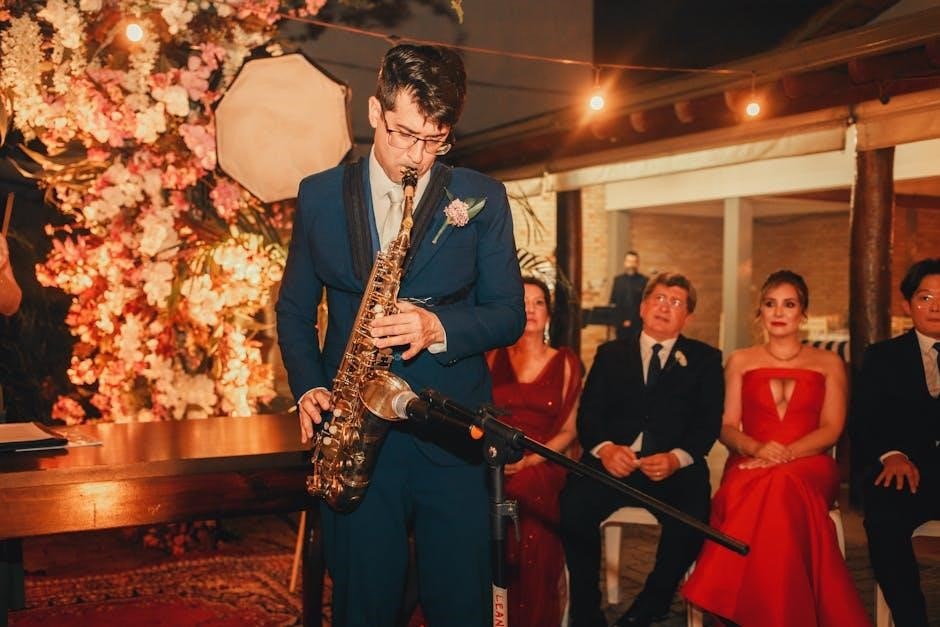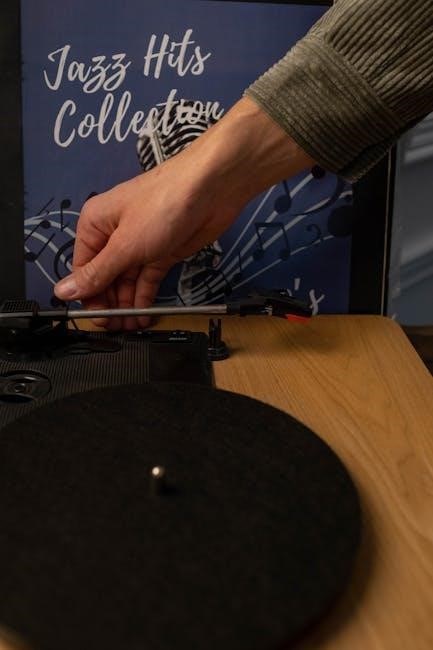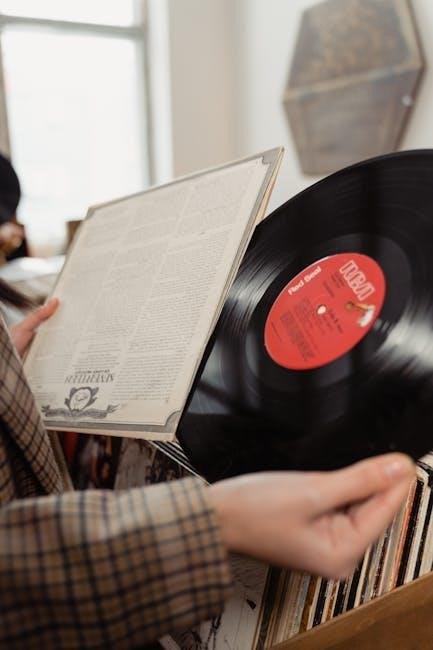This comprehensive guide explores jazz history‚ styles‚ and influential artists‚ offering essential listening tracks and updated digital access for a deeper appreciation of the genre.
Overview of the Book and Its Importance
Jazz: Essential Listening 2nd Edition is a foundational guide for understanding jazz history‚ styles‚ and influential artists. Written by Scott DeVeaux and Gary Giddins‚ it provides a comprehensive exploration of the genre‚ from its origins to modern interpretations. The book is structured chronologically‚ covering key eras such as early jazz‚ the swing era‚ bebop‚ and contemporary jazz. It features detailed listening guides‚ iconic albums‚ and insights into legendary musicians like Louis Armstrong‚ Duke Ellington‚ and Miles Davis. This edition includes updated tracks‚ new artists‚ and enhanced digital access‚ making it a vital resource for both students and jazz enthusiasts. Its importance lies in its ability to bridge education and enjoyment‚ offering a deeper appreciation of jazz while remaining accessible to all levels of listeners.
Authors: Scott DeVeaux and Gary Giddins
Scott DeVeaux and Gary Giddins are renowned experts in jazz history and criticism‚ bringing unparalleled insight to Jazz: Essential Listening 2nd Edition. DeVeaux‚ a jazz historian‚ and Giddins‚ a celebrated critic and author‚ collaborated to create a comprehensive resource that bridges academic depth and accessible storytelling. Their work is widely regarded for its meticulous research and engaging narrative style. Published by W;W. Norton & Company‚ the book has become a cornerstone in jazz education‚ adopted in courses worldwide. Both authors are praised for their ability to illuminate the genre’s evolution and significance‚ making their collaboration a definitive voice in jazz scholarship. Their expertise ensures that the book is both informative and inspiring‚ catering to students and enthusiasts alike.
Structure and Content of the Book
The book is organized chronologically‚ tracing jazz from its origins to modern times. It features detailed chapters on early jazz‚ the swing era‚ bebop‚ and beyond‚ blending history‚ analysis‚ and listening guides to create a rich‚ immersive experience for readers.
Early Jazz: Origins and Evolution
Early jazz emerged in the late 19th and early 20th centuries‚ rooted in African-American musical traditions like blues‚ ragtime‚ and spirituals. New Orleans‚ with its cultural melting pot‚ is often cited as the birthplace of jazz. The genre evolved from collective improvisation and syncopated rhythms‚ blending African and European influences. Key figures such as Jelly Roll Morton and King Oliver helped shape its early sound. By the 1920s‚ jazz had spread nationally‚ with cities like Chicago and New York becoming hubs. This era emphasized spontaneity and creativity‚ laying the foundation for future styles. The book provides in-depth analysis of these formative years‚ highlighting how early jazz set the stage for the genre’s global impact.
The Swing Era: Big Bands and Jazz Orchestras
The Swing Era‚ spanning the 1930s and 1940s‚ marked a golden age for jazz‚ dominated by large ensembles known as big bands. Bandleaders like Duke Ellington‚ Count Basie‚ and Benny Goodman rose to fame‚ blending intricate arrangements with infectious rhythms. This period emphasized danceable music‚ with swing becoming a cultural phenomenon. Iconic venues like Harlem’s Savoy Ballroom and Chicago’s Savoy Theater hosted legendary performances. The era also saw the rise of vocalists such as Ella Fitzgerald and Billie Holiday‚ who brought jazz to a broader audience. The book delves into the historical context‚ key musicians‚ and the social impact of swing‚ illustrating how it transformed jazz into a mainstream force.
Bebop and Cool Jazz: The 1940s and 1950s
Bebop and Cool Jazz emerged in the 1940s and 1950s‚ marking a shift toward complexity and experimentation. Bebop‚ led by Charlie Parker and Dizzy Gillespie‚ emphasized fast tempos‚ intricate harmonies‚ and virtuosic improvisation. This era saw the rise of smaller ensembles and a focus on individual expression. Cool Jazz‚ pioneered by Miles Davis and Chet Baker‚ offered a more relaxed‚ introspective sound‚ often incorporating classical influences. The book explores iconic tracks like Parker’s “Now’s the Time” and Davis’s “So What‚” highlighting how these movements redefined jazz. This period also bridged the gap between jazz and intellectualism‚ making it a cornerstone of modern jazz history.
Modern Jazz: The 1960s and Beyond
Modern Jazz‚ spanning the 1960s and beyond‚ saw a radical transformation of the genre. Artists like John Coltrane‚ Miles Davis‚ and Herbie Hancock pushed boundaries‚ experimenting with free jazz‚ fusion‚ and avant-garde sounds. Coltrane’s spiritual explorations in A Love Supreme and Davis’s groundbreaking Bitches Brew redefined jazz. This era also embraced global influences‚ incorporating elements from world music and electronic innovation. The book highlights how modern jazz blurred genre lines‚ creating a diverse and eclectic landscape. Essential tracks from this period showcase the genre’s evolution‚ emphasizing creativity and experimentation. This section provides a comprehensive guide to understanding the innovative spirit of modern jazz and its enduring impact on music today.

Key Artists and Their Contributions

Key jazz artists like Louis Armstrong‚ Duke Ellington‚ Miles Davis‚ and John Coltrane shaped the genre with pioneering techniques‚ legendary compositions‚ and transformative improvisations.
Louis Armstrong: The Father of Jazz
Louis Armstrong‚ a pivotal figure in jazz history‚ revolutionized the genre through his expressive trumpet playing and gravelly vocals. His innovative improvisations and charismatic stage presence redefined jazz‚ shifting focus from collective ensemble playing to individual solos. Armstrong’s mastery of phrasing and melodic reinterpretation set new standards‚ while his vocals‚ marked by scat singing‚ added a unique dimension. Tracks like “What a Wonderful World” and “Hello Dolly!” showcase his enduring legacy. Armstrong’s influence extended beyond music‚ as he became a cultural icon and advocate for civil rights. His contributions remain central to jazz education and appreciation‚ solidifying his role as a foundational artist.
Duke Ellington: The Genius of Composition
Duke Ellington‚ one of jazz’s most celebrated composers and bandleaders‚ left an indelible mark on the genre. Leading the Duke Ellington Orchestra‚ he created thousands of compositions‚ blending jazz with classical and popular music. His works‚ such as “Take the A Train” and “Mood Indigo‚” exemplify his mastery of harmony and orchestration. Ellington’s collaborations with Billy Strayhorn further enriched his legacy. His compositions often reflected storytelling and emotional depth‚ showcasing his genius. The 2nd edition highlights Ellington’s pivotal role in shaping jazz‚ making his music essential for understanding the genre’s evolution. His innovative spirit and enduring influence remain central to jazz education and appreciation‚ ensuring his work continues to inspire future generations.
Miles Davis: The Evolution of Jazz
Miles Davis was a pivotal figure in shaping the trajectory of jazz‚ embodying its evolution through various stylistic transformations. From his early days as a bebop trumpeter to his pioneering work in cool jazz with “Birth of the Cool‚” Davis consistently pushed boundaries. His iconic album “Kind of Blue” remains a cornerstone of modal jazz‚ while “Bitches Brew” ushered in the fusion era‚ blending jazz with rock and electronic elements. Davis’s ability to adapt and innovate made him a central figure in jazz history. His collaborations with legendary musicians and his improvisational genius solidified his legacy. The 2nd edition emphasizes Davis’s role in redefining jazz‚ making his work indispensable for understanding the genre’s developmental arc.
John Coltrane: The Spiritual Side of Jazz
underscores Coltrane’s influence‚ emphasizing how his music became a vehicle for spiritual exploration and continues to inspire listeners and musicians alike.

Essential Listening Tracks
Discover iconic jazz recordings that define the genre’s evolution‚ from classic standards to groundbreaking albums‚ curated to represent pivotal styles and eras in jazz history.
Classic Jazz Standards
provides detailed listening guides‚ helping listeners appreciate the historical and cultural context of these enduring pieces. Exploring these classics is a must for any jazz enthusiast.
Iconic Jazz Albums
provides insightful commentary on these albums‚ highlighting their historical significance and artistic brilliance. Exploring these iconic recordings offers a deeper understanding of jazz’s transformative power and enduring legacy.
Modern Interpretations of Jazz

highlights such modern innovators‚ demonstrating how jazz continues to evolve; Albums like Washington’s The Epic and Glasper’s Black Radio exemplify this fusion‚ proving jazz remains vibrant and dynamic. These works not only honor tradition but also push boundaries‚ ensuring jazz stays a vital force in today’s musical landscape.

Features of the 2nd Edition
The 2nd edition enhances the original with updated listening guides‚ expanded artist coverage‚ and improved digital resources‚ offering a richer exploration of jazz history and evolution.
Updated Listening Guides
The 2nd edition of Jazz: Essential Listening features extensively revised and expanded listening guides‚ providing deeper insights into key tracks and artists. These guides now include detailed analyses of newly added recordings‚ reflecting the evolution of jazz styles and subgenres. Readers benefit from enhanced commentary on historical context‚ musical techniques‚ and the cultural significance of each piece. The updates ensure a more comprehensive understanding of the genre’s development‚ from early jazz to modern interpretations. Improved annotations also highlight lesser-known artists and their contributions‚ offering a broader perspective. These updates make the guide indispensable for both students and enthusiasts seeking to explore jazz more thoroughly.
New Artists and Tracks
The 2nd edition of Jazz: Essential Listening introduces a fresh roster of artists and tracks‚ enriching the reader’s exploration of the genre. New entries include contemporary jazz musicians like Kamasi Washington and Cécile McLorin Salvant‚ showcasing the genre’s modern vibrancy. These additions highlight the evolution of jazz‚ blending traditional influences with innovative sounds.Tracks from emerging artists provide a bridge between classic and cutting-edge styles‚ offering listeners a well-rounded perspective. This expanded roster ensures the book remains relevant to both longtime fans and newcomers. The inclusion of these new voices underscores the dynamic nature of jazz‚ making the 2nd edition a valuable resource for understanding its past‚ present‚ and future.
Enhanced Digital Access
The 2nd edition of Jazz: Essential Listening offers enhanced digital access‚ providing readers with a seamless and immersive learning experience. The book now includes interactive listening guides‚ allowing users to stream tracks directly from the text. This feature is complemented by cross-platform compatibility‚ ensuring accessibility on both desktop and mobile devices. Additionally‚ the digital version includes high-quality audio samples and video clips that enhance understanding of complex musical concepts. The enhanced digital access also supports offline use‚ making it convenient for readers to study and enjoy the content anywhere. These improvements make the 2nd edition a modern and user-friendly resource for jazz enthusiasts and students alike‚ fostering a deeper connection with the music.

How to Access the 2nd Edition for Free

Access the 2nd edition for free by searching for “Jazz Essential Listening 2nd Edition PDF free” online‚ exploring library resources‚ or utilizing educational platforms offering free downloads.
Platforms for Free PDF Downloads
Several platforms offer free PDF downloads of Jazz Essential Listening 2nd Edition. Websites like Library Genesis or PDF Drive often host such materials‚ though users should verify legality. Academic platforms like ResearchGate or Scribd may also have shared copies. Additionally‚ some online communities or forums dedicated to jazz studies might provide access. Always exercise caution to avoid malicious links or pirated content. For a safer route‚ consider checking public libraries or educational institutions that offer free access to e-books. Remember to respect copyright laws and support authors by purchasing official copies when possible.
Temporary Access Options
For those seeking temporary access to Jazz Essential Listening 2nd Edition without committing to a purchase‚ several options exist. Free trial periods from services like Scribd or Kindle Unlimited can provide limited-time access to the PDF. Additionally‚ some online libraries or academic platforms may offer temporary borrowing privileges. Websites offering preview snippets or excerpts can also give a glimpse into the content. It’s important to explore these avenues responsibly‚ ensuring compliance with copyright laws. Temporary access can be a useful way to preview the book before deciding to purchase or download it permanently. Always consider supporting authors and publishers by acquiring official copies when possible.

Legal Considerations
When seeking a free PDF of Jazz Essential Listening 2nd Edition‚ it’s crucial to consider legal implications. Copyright laws protect published works‚ and unauthorized downloads or sharing may infringe on these rights. Accessing or distributing the book without permission could lead to legal consequences. Always ensure that any free access is obtained through legitimate channels‚ such as official promotions or trials offered by publishers. Supporting authors and publishers by purchasing the book or accessing it through licensed platforms is the most ethical approach. This not only respects intellectual property but also contributes to the creation of future educational resources. Be cautious of websites offering free downloads‚ as they may violate copyright laws or contain malicious content.
Supplementary Resources
The book is complemented by online resources‚ including a companion website with listening guides‚ interactive timelines‚ and downloadable materials. Additional tools enhance the learning experience.
Companion Website and Online Materials
The companion website offers extensive online materials‚ including interactive listening guides‚ quizzes‚ and downloadable resources. It features audio examples‚ analysis tools‚ and timelines to enhance understanding. Students and educators can access supplementary PDFs‚ such as chord charts and historical documents‚ to deepen their exploration of jazz. The site also provides discussion forums and video lectures‚ fostering engagement and collaboration. Regular updates ensure the content stays relevant and aligns with the book’s curriculum. These digital resources create a comprehensive learning environment‚ making the study of jazz more accessible and immersive for everyone.
Recommended Jazz Documentaries
Several documentaries complement the insights from Jazz: Essential Listening 2nd Edition‚ offering visual and narrative depth to the genre. Ken Burns’ Jazz series is a landmark‚ tracing the history of jazz with interviews and archival footage. Miles Davis: Birth of the Cool and John Coltrane: Chasing Trane provide intimate looks at iconic figures. The Jazz Ambassadors explores jazz diplomacy during the Cold War‚ while Keep on Keepin’ On highlights modern mentorship. Blue Note Records: Beyond the Notes delves into the label’s legacy. These films enrich the listening experience‚ blending history‚ culture‚ and artistry. They are essential for anyone seeking a deeper connection to jazz’s story and its enduring impact.
Jazz History Courses and Lectures
For a deeper understanding of jazz‚ several online courses and lectures align perfectly with the insights from Jazz: Essential Listening 2nd Edition. Platforms like Coursera and edX offer courses such as “The History of Jazz” by Yale University‚ taught by Professor John Szwed‚ which explores the genre’s evolution and cultural significance. Similarly‚ MasterClass features lessons by jazz legends‚ offering practical and historical perspectives. These resources provide structured learning‚ complementing the book’s listening guides and historical context. They are ideal for students and enthusiasts seeking to enrich their knowledge of jazz history‚ theory‚ and its influential artists. These courses serve as a valuable supplement to the book‚ reinforcing key concepts and expanding one’s appreciation of the genre.

Reviews and Recommendations
Critics praise Jazz: Essential Listening 2nd Edition for its comprehensive insights and accessible style. Educators and readers alike commend its effectiveness in guiding listeners through jazz history and innovation.
Student Feedback and Testimonials
Students universally praise Jazz: Essential Listening 2nd Edition for its clarity and depth. Many highlight how the book bridges theory and practice‚ making complex concepts accessible. The updated listening guides are particularly commended for enhancing their understanding of jazz history and innovation. Several students appreciate the inclusion of modern artists‚ which helps connect classic styles to contemporary sounds. The enhanced digital access is also a favorite‚ with many noting how it simplifies studying on the go. Overall‚ the book is celebrated as an invaluable resource for both beginners and advanced learners‚ fostering a deeper appreciation for jazz and its evolution.
Academic Endorsements
Jazz: Essential Listening 2nd Edition has garnered widespread acclaim from scholars and educators. Leading jazz educators praise the book for its meticulous research and ability to present complex musical concepts in an engaging‚ accessible manner. Universities worldwide have adopted it as a core textbook‚ with many noting its balanced approach to historical context and modern innovations. The updated edition’s expanded coverage of diverse artists and styles has been particularly lauded. Academics appreciate how the book bridges the gap between theory and practical listening‚ making it indispensable for both undergraduate and graduate studies. Its integration of enhanced digital resources further solidifies its reputation as a cornerstone of jazz education.
Comparisons to Other Jazz Resources
Jazz: Essential Listening 2nd Edition stands out among jazz resource materials for its comprehensive and balanced approach. Unlike other books‚ it seamlessly integrates historical narrative with practical listening exercises‚ making it more engaging for students. While many jazz textbooks focus narrowly on either historical context or modern styles‚ this edition provides a holistic view‚ bridging eras and genres. Its structured listening guides and updated tracks surpass competitors‚ offering a more immersive learning experience. Additionally‚ the inclusion of diverse artists and styles sets it apart from resources that often overlook lesser-known contributors. This makes it a superior choice for both casual learners and academic programs seeking a well-rounded jazz education resource.
Jazz: Essential Listening 2nd Edition is a vital resource for jazz enthusiasts‚ offering a rich exploration of the genre’s history and evolution. It inspires deeper appreciation and exploration of jazz music.
Final Thoughts on the Book’s Value
Jazz: Essential Listening 2nd Edition stands as an indispensable guide for both newcomers and seasoned enthusiasts. Its meticulous curation of tracks and insightful commentary provide a comprehensive understanding of jazz history and its cultural significance.
The updated edition enhances the learning experience with new tracks and digital resources‚ making it a must-have for anyone seeking to deepen their appreciation of this vibrant musical tradition.
Encouragement to Explore Jazz Further
Jazz is a timeless art form that continues to evolve‚ offering endless opportunities for discovery. This book serves as a gateway to explore the rich history and diverse styles of jazz‚ from its roots to modern interpretations.
Listeners are encouraged to venture beyond the tracks and delve into live performances‚ local jazz scenes‚ and the stories behind the music. Jazz is not just a genre but a cultural experience that fosters connection and creativity.
By embracing this journey‚ one can uncover the depth‚ emotion‚ and innovation that define jazz‚ ensuring its legacy thrives for future generations.